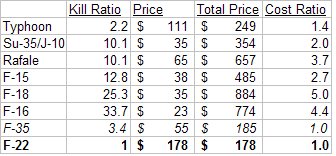 As I mentioned a few posts ago, one of my major concerns about a Democratic victory in the November Elections is that they will cut new weapons programs to free up money for domestic spending. This attitude can be seen in this report by the Council on Foreign Relations. The general thrust of the report is that the military doesn’t need all the new expensive weapons in development, especially with the current wars ongoing. Yet this concept of mortgaging our future military power to make the present situation cheaper would be a grave mistake if carried out.
As I mentioned a few posts ago, one of my major concerns about a Democratic victory in the November Elections is that they will cut new weapons programs to free up money for domestic spending. This attitude can be seen in this report by the Council on Foreign Relations. The general thrust of the report is that the military doesn’t need all the new expensive weapons in development, especially with the current wars ongoing. Yet this concept of mortgaging our future military power to make the present situation cheaper would be a grave mistake if carried out. One of the major focuses of the report, and the Democrats, is Air Force fighter procurement. Probably the most glaring error in this report is that it claims US fighters are superior to anything around the world for the foreseeable future (something Democrats have also claimed). That is flat out wrong. This site has the results of the British Defense Evaluation and Research Agency study (near bottom of page) about the combat effectiveness of current and next generation fighters. As can be seen, no current US fighter, with the possible exception of the Navy’s Super Hornet, is a match for the Russian Su-35, Eurofighter Typhoon, or French Rafale. The article also notes that the Chinese J-10 (Pakistani F-10) regularly outperforms Su-35’s in training so that fighter may also be added to the list. Thus, far from our fighters being superior for the next decade or two, current and potential opponents like China, Russia, the countries Russia supplies weapons to (Venezuela, Iran, Syria, any other anti-American country with cash), Pakistan, and France either have or have access to better fighter planes than we do. While true that none of these countries approaches the US Air Force in training or experience, it does not mean that will remain the case forever. Even without the training to challenge the USAF directly, such advanced fighters would cause major problems for a US military dependant on total control of the air simply by being an X factor, or if you prefer an air force in being (that is, rather than doing things like supporting ground troops some American fighters will have to be on constant watch for them, missions must always take their presence into account, etc. depleting force strength).
Something that also has to be considered (the report does mention it near the end) is that the Air Force must contend not only with enemy fighters but also with enemy surface to air missiles. As SAM’s, radars, and communication equipment become more capable and widely utilized, we need to have something other than 20 $2 billion B-2’s and 36 well past their prime F-117’s that can reasonably operate against them. This isn’t a major problem if our enemy either gives us the time we need to pick apart their air defenses (Iraq 91) or doesn’t have a serious air defense (Iraq 03). However, seeing as the only occasions of that occurring involved the same stupendously stupid Saddam, we shouldn’t allow ourselves to rely on it. A war with China, North Korea, Iran, or any number of countries would not afford us either of those luxuries. The F-22 would especially fill this need as it is extremely stealthy, fast, maneuverable, and has a 2,000 lb bomb load. This makes the F-22 capable of performing, amongst its many other missions, the F-117’s vital mission. The F-22 would thus be doubly useful in the initial phase of a war as an air defense suppressor/ground attack (admittedly limited in this respect), and an air superiority fighter still capable of intercepting enemy aircraft (this is an Air Force story on the F-22's effectiveness, biased of course though still useful). Except in ground attack where it is 7 times more capable, the F-35 is not as stealthy, capable, or as expensive as the F-22. It is still useful since it’s far superior and not too much more expensive than the 25 year old F-16. It would also be more survivable in a weak but still operational air defense environment and versus the more advanced fighters now in service around the world. These would both limit the employment of the F-16 and raise their losses. It should go without saying that if our air support is limited or attritted, our ground forces will also suffer more casualties and a tougher war.
One of the biggest complaints is that no matter how effective these aircraft are at their missions, do we actually need them to perform those missions? It doesn’t take much thinking to realize that the F-22 would be of almost no use in Afghanistan or after the first day in Iraq. By this argument though, we hardly need an Air Force at all. A half dozen B-1’s and B-52’s plus several dozen A-10/F-16/F-18's are all that is needed in each country. Since that’s all we need for brushfire wars, then why should we keep around 500 F-15’s, 700 F-18, 900 F-16, 270 A-10, and 180 bombers? The reason should be obvious, the Air Force has more jobs than simply supporting counter-insurgency operations. The military in general needs to be prepared for both COIN and conventional wars, not only one or the other. If we make the opposite mistake we made during the Cold War, and only prepare for COIN wars then we will pay dearly for it in a future conventional war. If we get caught off guard and unprepared by a war with China, we will be lucky to keep the number of killed below 600 per week much less per year as in Iraq. While conventional wars are rarer and deterable, they are not deterred by throwing up 30 year old fighters against a nation(s) rapidly arming with the latest fighters and missiles. That is simply a recipe for miscalculation, the mother of great power wars.
So on to another complaint, though the F-22 and F-35 would be an extremely effective pair, are they worth the great expense? The heart of this question is whether the F-15 and F-16 are still capable enough to do the job at much lower cost. The advantages versus SAM’s and in supporting ground troops is hard to quantify beyond saying the F-22/F-35 would be more capable than current aircraft (venerable A-10 excepted). The F-35 isn’t as much in debate since its total cost per plane of $115 million is not that great. The bigger debate is over the F-22 and its $340 million per plane price tag quoted by critics. The first thing to realize is that of the $340 million, $150 million represents development cost that we have mostly already paid. Moreover, it is unfair to attribute all of that cost to the F-22 since its R&D spending has helped lower the development cost for the F-35 and various UAV’s. A further $50 million (based on the $137 million construction cost) is the cost of setting up the production line that has mostly been paid as well. This $200 million of the price tag is essentially fixed and is therefore dependant on the number of aircraft purchased and would drop to $100 million if 360 F-22’s were purchased instead of 180. It would also be lower if the Congress would approve the FB-22. This would be a fighter-bomber based on the F-22 with somewhat inferior air-to-air capabilities replaced with a far superior 7,500 lb payload and range.
Whatever the price, how does the F-22 stack up against its rivals? The aforementioned DERA fighter study indicates how it would in a straight up fight. Although US fighters will likely never be in a straight up fight, it does still provide a good indication of their relative performance. The following table has the kill ratios vs the F-22 of various current aircraft from the DERA study, the purchase price of each aircraft from Defense-Aerospace.com amongst others, and then their total price per kill and vs the F-22. (note: the F-35 was not including in the DERA study, I just used the roughly 3:1 capability difference between the F-15 and F-16 as guideline)
 It thus becomes evident that far from being the most expensive aircraft for conventional conflict, the F-22 is one of the cheapest. Further, it should be noted that in addition to dollars, losing almost 13 F-15’s compared with 1 F-22 means 12 more lost pilots.
It thus becomes evident that far from being the most expensive aircraft for conventional conflict, the F-22 is one of the cheapest. Further, it should be noted that in addition to dollars, losing almost 13 F-15’s compared with 1 F-22 means 12 more lost pilots.
I am certainly not arguing for the defunding of the current wars or COIN preparations in favor of conventional war programs like the F-22 and F-35. The cost of these two programs is $8.1 billion this year. We are completely capable of funding them, current operations, and future COIN programs at the same time. If one or the other is not receiving enough then we need to increase the defense budget, not eliminate any of the programs. If necessary, this is one of the rare situations where it is better to under fund each somewhat than it is to fund 2 completely and 1 not at all. We have to be able to conduct brushfire wars or else the chaos in much of the world will spread and eventually possibly threaten the civilized word. But we also must not make the same mistake the British made twice and focus solely on “imperial policing”, thereby simultaneously raising the odds of a great war and its length and severity. Around an extra $150 billion a year to guard against each outcome is a small price to pay given the cost of ignoring them (e.g., WWII would cost us something like $30 trillion today). If the Republicans do not fully understand that now, they at least will when it becomes unavoidable. The modern Democrats never have or will.


Thanks for the comment, I don't know about a lot of people reading the post but thanks anwyays. COIN means counterinsurgency, a war like in Iraq in Afghanistan. Conventional wars are like Korea or World War II. The Su-35 (or the J-10 variant) is used by China and Pakistan. Numerous countries use the less capable variant of the Su-35, the Su-27. Whatever the longterm smarts in selling advanced weapons to potential enemies, the Russians are doing it. The F-35 is still in development, the F-22 is in production. The first squadron became operational this year.
ReplyDelete